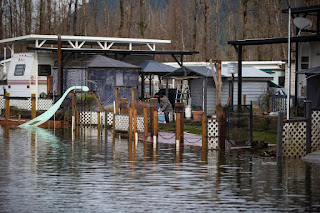Climate change will cost us billions — and then it will get even worse
Climate change will cost us billions — and then it will get even worse
By Heather Scoffield Economics Columnist
Tue., Dec. 7, 2021
There’s a harsh
subtext to Peter Weltman’s finding that when climate disaster strikes Ontario,
the cost to government-owned buildings will be in the billions of dollars.
Weltman is the
Ontario government’s fiscal accountability officer, the watchdog who answers
legislators’ queries about spending and liabilities. He was asked two years ago
to assess the implications of climate change on Ontario’s public assets.
His answer is
coming out in bits and pieces — partial glimpses of a larger picture that is
troubling, expensive and requires urgent attention from all levels of
government and the private sector alike.
On the surface, the
cost of climate change looks relatively manageable. The FAO report published
Tuesday looks at provincial and municipal buildings currently worth $254
billion, and concludes that extreme weather would impose between $800 million
and $1.5 billion a year in additional maintenance costs.
The province is
already spending about $10 billion a year just to maintain the status quo.
The extra cost is a
lot — but it’s not a showstopper, at least not taken on its own. The FAO,
however, had a very narrow scope, by design. The bigger picture is far more
worrisome.
Weltman had to take
into account his resources, his mandate and the scope of publicly available
research to zero in on something he could actually analyze with heft. He stuck
to buildings, and left transportation and water infrastructure until later. He
also limited the climate threat to just three elements — extreme rainfall,
extreme heat and freeze-thaw cycles.
The rising costs of
an expected increase in rain and heat are somewhat offset by the diminishing
costs of less frequent freeze-thaw cycles. And the costs are higher if we don’t
start beefing up our structures right away, and much higher still if we do
nothing and leave infrastructure to the elements.
The report makes
all that clear.
But if, say, an
atmospheric river came along and damaged a hospital, only the direct cost of
repairing that hospital would be in the report. If there was also flooding
nearby, damage to other non-government buildings, car wreckage, houses
crumbling and other non-government destruction, those costs would not be in the
report.
If there were
disruptions to power and road closures that meant work cancellations, supply
chain disruptions and widespread chaos, those costs would not be in the report
either.
And if people were
hurt or died or were left distressed, those costs don’t show up either.
“They didn’t have
the mandate to look beyond the direct costs,” says Ryan Ness, adaptation
research director at the Institute for Climate Choices.
There’s a stark
message though. If extreme weather would cost Ontario taxpayers billions, it
would cost federal taxpayers much more, and would cost the private sector many
multitudes more. And we are nowhere close to understanding those costs, let
alone preparing to pay for them.
Ness points out
that the FAO didn’t consider flooding because it couldn’t track down enough
floodplain mapping. As a result, the researchers didn’t know exactly what had
happened in the past let alone attempt to project what would happen to
buildings in the future. And without those projections, they couldn’t even
begin figuring out what the broader cost on related infrastructure, the
workforce and people at risk would be.
Of course, the
real-life backdrop here is British Columbia, where a series of catastrophes
this year has destroyed lives, agriculture and infrastructure indiscriminately,
and the cost of repairs will be in the many billions of dollars — as well as in
human and animal life.
While weaknesses in
the province’s dam and floodplain systems were known, the effects on supply
chains and transportation were not fully imagined. No one thought about the
possibility that crucial parts of the province would be cut off from each
other.
At least we’ve
started talking about the costs of climate change that are already upon us and
have some policy in place to cut emissions and limit climate change over the
long term. The federal Liberal commitment to produce a national climate
adaptation plan by the end of the 2022 will take us further in our
understanding of what’s needed, even if it is dreadfully late to the party.
We haven’t even
started to imagine the societal costs of adapting to climate change.
In a recent report,
the World Bank estimates that 216 million people will be on the move because of
climate impacts by 2050, leaving areas where there will be either not enough
water or too much, and searching for land that can support them. The surge will
start as early as 2030.
Canada barely has
enough infrastructure and housing to handle its current flow of migrants, let
alone many millions more.
There’s so much
hard work to be done in researching, projecting and preparing for the
inevitable, let alone preventing worse to come.
We’re waking up to
this too slowly.

Comments
Post a Comment